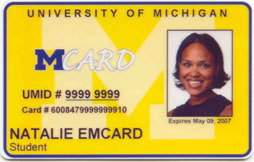Natalie Emcard
August 7th, 2005Looks like Nat is moving on to other things… gone from Student to Translator.. lol.


Update: I was recently informed she now works with the NNSA, the National Nuclear Security Administration.

Looks like Nat is moving on to other things… gone from Student to Translator.. lol.


Update: I was recently informed she now works with the NNSA, the National Nuclear Security Administration.

Here’s a listing of some of the URLs you can as links on HTML pages to interact with AIM.
Adding Buddies
aim:addbuddy
aim:addbuddy?screenname=screen+name
aim:addbuddy?screenname=screen+name&groupname=group+name
Buddyicons
aim:buddyicon?src=image_source
aim:buddyicon?screename=screen+name
aim:buddyicon?src=image_source&screename=screen+name
Get Files
aim:getfile
aim:getfile?screenname=screen+name
Register Users
aim:registeruser
aim:registeruser?screenname=screen+name
aim:registeruser?screenname=screen+name&password=password
aim:registeruser?screenname=screen+name&password=password&signonnow=true
Check Email
aim:CheckEmail?Address=what@what.com
Adding Games
aim:addgame?name=Game
aim:addgame?name=Game&hideIMs=true
aim:addgame?name=Game&hideIMs=true&multiplayer=true
aim:addgame?name=Game&hideIMs=true&multiplayer=true&url=www.url.com
AIM Today
aim:aimtoday?url=http://www.google.com
Away Messages
aim:goaway?message=Message+Here
Themes
aim:GetExpression?URL=url+to+theme
Sending IMs
aim:goim?screenname=screen+name+here
aim:goim?screenname=screen+name+here&message=your+message
OpeningChat
aim:GoChat?RoomName=chatroom+name+here&Exchange=4
Note to self… invest in Wi-Fi Phones. I predict you will get back 5 times what you put in in 10 years.
I predicted Google was going to go way up as soon as it came out with its IPO. It has tripled.
When I saw a squirrel sitting on the couch I closed the outside door and went to go grab the camera. I took these pictures:
So, yea, I just figured out why my apartment smelled like sparklers the other night after a popping sound.
Today I was going to cook some beef on the stove for sloppy joe’s and after a few minutes I realized the stove wasn’t working. Hmm… I thought, what could be wrong. Sure enough my guess was right. I went over to the circuit breaker panel and the huge switch at the top was blown. At first I thought that was the one for the entire house, but considering all my other stuff was still working with that off, I guess that wasn’t it. So, I flipped it back on, and immediately heard a loud crackling sound in the kitchen. I rushed over there and the back of the stove had flames about a foot high. Wow. I turned that sucker back off. So, now, once again my apartment smells like sparklers.
Oh, and I’m still alive.
How am I going to cook 1 lb of beef now???
Cross-posted to the Google Maps API discussion group (click here):
There has been a lot of discussion on a large amount of overlays on a single Google map. Different hacks have approached this problem in different ways. Many sites do not even deal with it because they can’t, don’t know how, or don’t want to.
The capability to display a huge amount of overlays I believe should be handled somehow by the Google Maps tool itself. However, since most, if not all of Google Maps is written in JavaScript this may be a problem. The JavaScript would have to load a large file and then query it. For JavaScript, this would take a long time if the file was large.
I’m going to explain a solution which is derived from what I’ve seen on a few different sites, and what I think would be the best. It uses PHP and MySQL, but I’m sure you could substitute in other technologies like ASP and Access, or JSP and Oracle for example. What would be an even better thing to do would be to figure out how to get a real GIS map server (Google it) to interact with Google’s native overlays, but for those of you who just need a simple solution, here it goes.
You would use PHP along with a MySQL table full of Overlay information. Then, the JavaScript would call a PHP function with the current bounds of the map which is represented by two points. It doesn’t matter how you call the function, just find a way. Then, PHP would use these two points to make a MySQL query on your table of points and only return those in the specified bounds back to the JavaScript. Then, the JavaScript would clear the map of markers and then redraw only the ones which are returned by your server (the ones that are currently in bounds).
I would appreciate questions and comments as I go ahead and implement this solution. Maybe someone has already done exactly this and open sourced their code. If so, I would love to hear about it to save me time.
-Kyle Mulka
http://maps.kylemulka.com
Update:
I forgot to discuss the problem of having too many overlays within a given bounds. That is kind of important. Oops. For example, if you are zoomed out all the way, your JavaScript will be handed all of the overlays in the world, and this will not help performance AT ALL for higher zoom levels. So, I’ll outline a general solution to this problem.
You need to organize overlays into groups. Visually, on a map, without knowing anything about the underlying data, I see only one general solution. If anyone has any others, I’d love to listen.
You would have an algorithm which reduces the number of overlays to display by automatically grouping overlays based on location. There are tons of ways to do this. I think the easiest way would be to split up the given bounds into four squares, then check each square to see if there are still to many markers in that square. If a square still has too many markers, simply divide that square into another four squares and count again. All of this information could be calculated ahead of time and stored in a database for painless and fast retrieval when queried. This is almost exactly what Google does with its map tiles. Each zoom level simply divides each tile (a square) into four smaller squares and displays the new four tiles. This is how Google Maps itself is so fast. They can simply save all of these tiles in a database or as image files for absolutely painless retrieval. There is almost no processing required on the server. It is extremely scalable.
Another improvement to this system may be to use the same system that Google uses to keep track of tiles. The tiles are cached on your computer, and when you go one way on a map, then go back, it doesn’t have to query the server for those tiles. It would be nice if you could some how cache the marker information in the browser as well.
-Kyle Mulka
http://maps.kylemulka.com
For anyone who knows what AJAX is, maybe you will find this somewhat amuzing like I did.
Optical Camouflage, cool! Check out the last video.
So, I visited Howstuffworks.com and clicked on one of the main items on the front page. I came to this page on How the Male Birth-control Pill Will Work. A lady in a doctor’s outfit popped up in the lower right corner of my browser and started talking to me. I was scared for a second because I had my sound turned way up. Then, I scrolled the page to see if I could get rid of her. Nope, she stayed put. I really don’t want to see a video advertising how botox works, thanks. Text, maybe, but please do freak me out like that.
I found this paper interesting to skim through. I didn’t actually read it. It shows a diagram of the TerraServer setup (most of the imagery used in Microsoft’s new Virtual Earth).
Don’t let the title scare you. Even if you don’t read it the pictures are pretty.
TerraServer Bricks – A High Availability Cluster Alternative